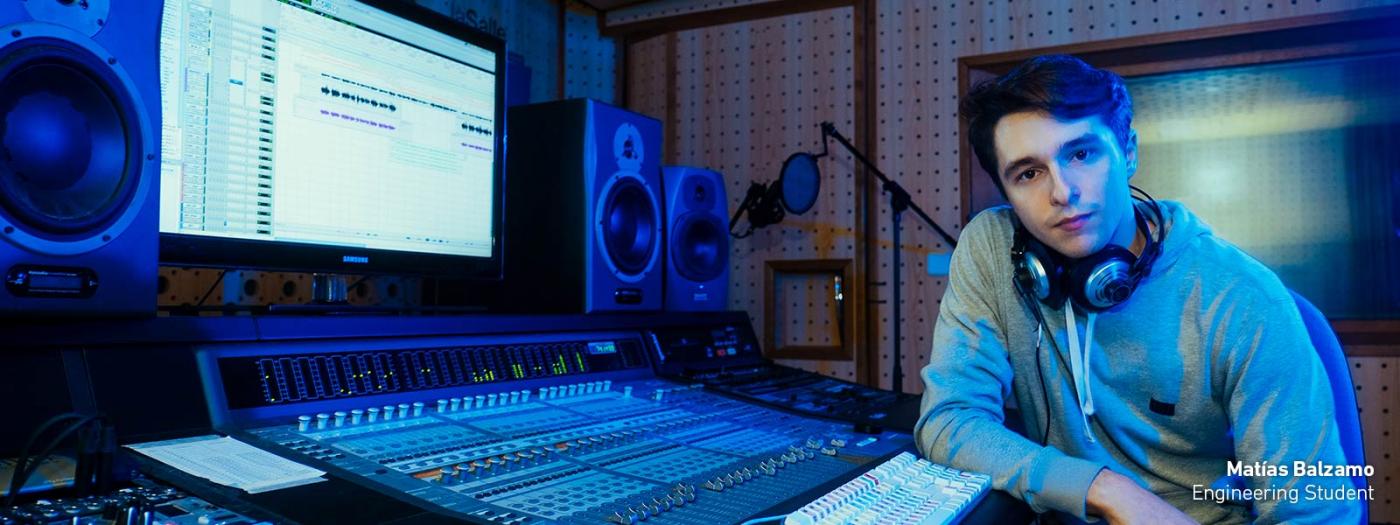Titular Professors
Fundamentals of Acoustic and Audio
1st SEMESTER. THEORY: MODAL ANALYSIS AND NOISE AND VIBRATION TRANSMISSION-CHANNELS ANALYSIS [~45h]
1. Basic concepts to solve acoustic and vibration problems [2h]
1.1. Decibel scale
1.2. Individual contribution of each source
1.3. Frequency information
1.4. Noise and vibrations: two aspects of the same problem
1.5. Summary
2. Modal analysis
2.1. Introduction
2.2. Analytic and experimental modal analysis
2.3. 1 degree of freedom system in free regimen
2.4. 1 degree of freedom system in forced regimen
2.5. 2 degrees of freedom system and N degrees of freedom
2.6. Modal parameters, modal vectors, participation factors, orthogonality and modal coordinate
2.7. Structural and proportional muffling
2.8. Estimation methods of modal parameters of 1 degree of freedom
2.9. Estimation methods of modal parameters of multiple degrees of freedom
2.10. Model validation
2.11. Introduction to operational modal analysis
2.12. Summary
3. Transmission-channels analysis [12h]
3.1. Frequency response functions
3.2. Definitions and hypothesis
3.3. Coherent and energetic factorization
3.4. Function matrix of volumetric velocity transference
3.5. Mechanic forces measurement with the operative system
3.6. Measurements with the operative system
3.7. Wrongly conditioned matrix
3.8. Introduction to operational transmission channels analysis
3.9. Summary
2nd SEMESTER: LABORATORY: PRACTICES [~45h]
4. P1. Signal and System analysis
4.1. Signal analysis
- Introduction to the two-channel analyzers BK 2034/2035 and Symphonie
- Spectral analysis: FFE, temporal resolution, frequency resolution, FFT, window, amitjanament, zoom, trigger, auto-rank
- Kinds of signal and measurement unities
- Calibration of a measurement chain
4.2. System Analysis
- Impulsion excitation
- Excitation with broadband signals
- Stimulators of a system´s frequency response
- Measurement coherency
- Cross-correlation
5. P2: Loudspeakers characterization
5.1. Frequency answer
- Introduction to the two-channel analyzer BK Pulse
- Loudspeakers´ frequency response measurement
- Loudspeakers´ directivity measurement
- Diffraction
6. P3: Attenuation coefficient in the reverberant room
6.1. Acoustic attenuation of a material in the reverberant room coefficient measurement protocol
- Introduction to the multi-channel analyzer NetdB
- Reverberant time measurement by the uninterrupted source method.
- Measurement of the acoustic attenuation coefficient of a material according to the measurement regulation UNE-EN 354
- Calculus sheet in Excel
6.2. Acoustic field diffusion
- Acoustic field diffusion qualification: sound pressure level deviation
- Room docking
7. P4. Material mechanical parameters
- Introduction to Shaker BK4009 and the accelerometers and charge analyzers.
- Young module measurement
- Muffling measurement
- Measurement from the theory of the modal parameters extraction based on the SDOF methods: peak picking and circle fitting
- Orbest method measurement
8. P5: Modal Experimental Analysis
- Introduction to the multi-channel analyzer OR38 and to the accelerometers ICP
- Impact hammer
- Analytic calculus of own modes
- Spatial sampling
- Parameter extracting methods
- Own modes forms visualization
1st semester
1. Magisterial classes
2. Problem classes
2nd semester
1. Magisterial classes´ contents exposition
Along the course, the professor will explain the subject´s basic theoretical concepts through magisterial classes. In these classes the professor will also solve exercises to apply the explained concepts.
2. Practices at the Acoustic Laboratory
Through the semester, the students do 5 practices in groups. The first day of the practice the professor explains the objectives and the basic concepts. Through the experimentation, students solve the exercises and experiments proposed. The second day of the practice, the professor will ask some questions to his pupils to make sure that they have understand the continents.
Between the two days of the practices, students may go to the laboratory to finish the proposed exercises.
1st Semester
Written exams at the end of the second semester (2~3h)
Continuous evaluation based on exercises and practices solved individually or in group (two additional notes to the exam each semester)
2nd Semester
The evaluation is made from an individual practical exam, a theoretical exam and the questions asked at the end of the practices.
The global grade is calculated with as explained below:
Theoretical exam = 15%
Practical exam = 70%
Questions about practice = 15%
The final exam is averaged if the Practical Exam grade is ≥ 3.5
2nd semester final grade = 0.70 Practical Exam + 0.15 Theory + 0.15 Questions
The attendance to the practice is obligatory. The practical sessions are 3 hours long and each practice has two sessions.
The students have a timetable to access the laboratory after class hours.
Practices are carried out in groups. Depending on the number of students, the groups may be formed by maximum three persons. Students must bring printed and read the practice statement corresponding to that week.
Subject evaluation
The evaluation of each semester is independent. The subject is passed if the Final Grade is equal to or higher than 5.
Final Grade = 0.50 Final Grade 1st Semester + 0.50 Final Grade 2nd Semester
The previous medium value will be only applied in the event that the grades of each semester are higher or equal than 4,5.
In the event that only one semester is passed, the grade will be keep for the next semester, but not for the following.
Semestre 1
Temes 2 i 3:
- D.J. Ewins, Modal testing: theory and Practice (Brüel & Kjaer) (1986)
- Z. Fu and J. He, Modal Analysis (Butterworth-Heinemann) (2001)
- W. Heylen, S. Lammens and P. Sas, Modal Analysis Theory and Testing (KUL Press) (1997)
- Transfer Path Analysis: the qualification and quantification of vibro-acoustic transfer paths, LMS
Semestre 2
- C.M. Harris and Crede, Shock & Vibration Handbook, Ed. McGraw-Hill, 1988.
- L. Beranek, L. Vér. Noise and Vibration Control Engineering, Ed. John Wiley & Sons, 1992.
- C. Hopkins, Sound Insulation, Ed. BH, 2007
- M.J. Crocker. Handbook of noise and vibration control. Ed. John Wiley & Sons, 2007
